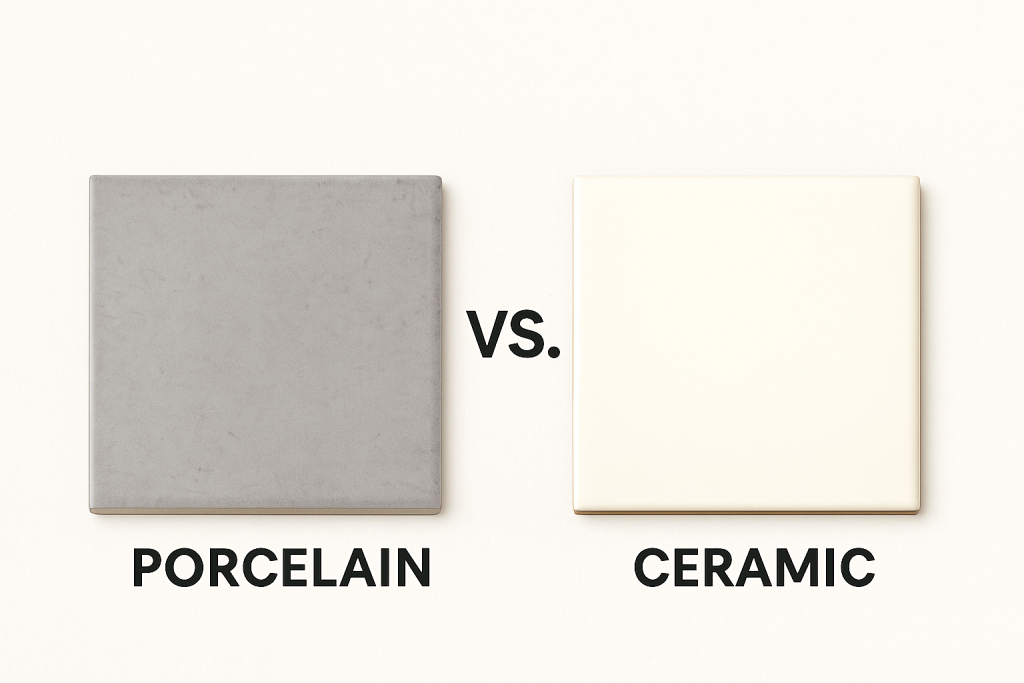Porcelain vs. Ceramic Tiles: What’s the Difference?
When choosing tiles for your home or business, one of the most common questions is: What’s the difference between porcelain and ceramic tiles? While both are popular, durable, and attractive options, there are key differences in their composition, performance, and best uses. This guide breaks it down so you can make the right choice for your project.
1. Composition & Manufacturing
Both porcelain and ceramic tiles are made from natural clay and other materials, then fired at high temperatures. The main difference lies in the clay mixture and firing process:
- Porcelain Tiles – Made from a finer, denser clay and fired at higher temperatures. This results in a tile with a low water absorption rate (typically < 0.5%), making it extremely strong and less porous.
- Ceramic Tiles – Made from a coarser clay and fired at slightly lower temperatures. They are still durable but have a higher water absorption rate compared to porcelain.
2. Strength & Durability
- Porcelain: More hard‑wearing and resistant to scratches, chips, and heavy traffic. Ideal for high‑use areas like hallways, kitchens, and commercial spaces.
- Ceramic: Durable, but better suited to lighter foot‑traffic areas such as bathrooms or feature walls.
3. Water Resistance
Because porcelain is denser and less porous, it’s more resistant to moisture. This makes it ideal for:
- Bathrooms and wet rooms
- Outdoor areas (when using frost‑proof porcelain)
- Kitchens and utility rooms
Ceramic tiles are more absorbent, so they’re generally recommended for indoor wall and floor use where heavy moisture is not a concern.
4. Design & Style
Both porcelain and ceramic tiles come in a huge variety of colours, patterns, and finishes — including wood, stone, marble, and concrete effects.
- Porcelain can be full‑bodied or through‑coloured, meaning the colour and pattern run through the tile — chips are less noticeable.
- Ceramic tiles usually have a surface glaze, which means chips may reveal the clay beneath.
5. Cost & Installation
- Porcelain: Generally more expensive due to higher manufacturing standards and durability. It’s also heavier and harder to cut, so installation may cost more.
- Ceramic: Usually more budget‑friendly and easier to work with, making it a great choice for DIY projects or large wall areas.
6. Quick Comparison
| Feature | Porcelain | Ceramic |
|---|---|---|
| Durability | ★★★★★ | ★★★★ |
| Water Resistance | ★★★★★ | ★★★ |
| Cost | Higher | Lower |
| Installation Difficulty | Harder | Easier |
| Best For | High traffic, wet areas, outdoors | Walls, light traffic, decorative areas |
Final Thoughts
If you need maximum durability, moisture resistance, and long‑term performance, choose porcelain tiles. If you’re after an affordable, stylish option for walls or low‑traffic areas, ceramic tiles are a fantastic choice.
Browse our ranges:
Porcelain Tiles
Ceramic Tiles
Need help calculating quantities or choosing the right finish? Contact our team for expert advice.

